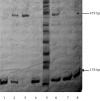Association of the Alu insertion polymorphism in the progesterone receptor gene with breast cancer in a Mexican population
- PMID: 26170848
- PMCID: PMC4495151
- DOI: 10.5114/aoms.2015.52357
Association of the Alu insertion polymorphism in the progesterone receptor gene with breast cancer in a Mexican population
Abstract
Introduction: The progesterone receptor (PR) gene plays an important role in reproduction-related events. Data on polymorphisms in the PR gene have revealed associations with cancer, particularly for the Alu insertion polymorphism, which has been suggested to affect progesterone receptor function and contribute to tumor promotion in the mammary gland.
Material and methods: We examined the role of the Alu insertion polymorphism in the PR gene by comparing the genotypes of 209 healthy Mexican women with those of 481 Mexican women with breast cancer (BC).
Results: The genotype frequencies observed in the controls and BC patients were 0% and 4% for T2/T2 (Alu insertion), 16% and 21% for T1/T2, and 84% and 75% for T1/T1 (Alu deletion), respectively. The obtained odds ratio (OR) was 1.7, with a 95% confidence interval (95% CI) of 1.1-2.6, p = 0.009, for the T1/T2-T2/T2 genotypes. The association was also evident when the distributions of the T1/T2-T2/T2 genotypes in patients in the following categories were compared: obesity grade II (OR = 1.81, 95% CI: 1.03-3.18, p = 0.039) and the chemotherapy response (OR = 1.91, 95% CI: 1.27-3.067, p = 0.002).
Conclusions: The T1/T2-T2/T2 genotypes of the Alu insertion polymorphism in the PR gene are associated with BC susceptibility in the analyzed Mexican population.
Keywords: Mexican population; PROGINS; breast cancer; polymorphism; progesterone receptor.
Figures


Similar articles
-
The rs2234694 and 50 bp Insertion/Deletion polymorphisms of the SOD1 gene are associated with breast cancer risk in a Mexican population.Eur Rev Med Pharmacol Sci. 2020 Aug;24(15):8017-8027. doi: 10.26355/eurrev_202008_22485. Eur Rev Med Pharmacol Sci. 2020. PMID: 32767328
-
PROGINS Alu sequence insertion is associated with hyperprolactinaemia but not leiomyoma susceptibility.Clin Endocrinol (Oxf). 2005 Apr;62(4):492-7. doi: 10.1111/j.1365-2265.2005.02251.x. Clin Endocrinol (Oxf). 2005. PMID: 15807882
-
Molecular Evaluation of PROGINS Mutation in Progesterone Receptor Gene and Determination of its Frequency, Distribution Pattern and Association with Breast Cancer Susceptibility in Saudi Arabia.Endocr Metab Immune Disord Drug Targets. 2020;20(5):760-770. doi: 10.2174/1871530319666191125153050. Endocr Metab Immune Disord Drug Targets. 2020. PMID: 31763970
-
Progesterone Receptor Gene Polymorphisms and Breast Cancer Risk.Endocrinology. 2023 Feb 11;164(4):bqad020. doi: 10.1210/endocr/bqad020. Endocrinology. 2023. PMID: 36702635 Free PMC article.
-
Impact of NR5A2 and RYR2 3'UTR polymorphisms on the risk of breast cancer in a Chinese Han population.Breast Cancer Res Treat. 2020 Aug;183(1):1-8. doi: 10.1007/s10549-020-05736-w. Epub 2020 Jun 23. Breast Cancer Res Treat. 2020. PMID: 32572717 Review.
Cited by
-
Repetitive Sequence Transcription in Breast Cancer.Cells. 2022 Aug 14;11(16):2522. doi: 10.3390/cells11162522. Cells. 2022. PMID: 36010599 Free PMC article.
-
Frequency of Alu insertions within the ACE and PR loci in Northwestern Mexicans.BMC Res Notes. 2017 Jul 27;10(1):339. doi: 10.1186/s13104-017-2673-y. BMC Res Notes. 2017. PMID: 28750672 Free PMC article.
-
Association of the PROGINS PgR polymorphism with susceptibility to female reproductive cancer: A meta-analysis of 30 studies.PLoS One. 2022 Jul 15;17(7):e0271265. doi: 10.1371/journal.pone.0271265. eCollection 2022. PLoS One. 2022. PMID: 35839271 Free PMC article.
-
Mutations in the Progesterone Receptor (PROGINS) May Reduce the Symptoms of Acute Hepatitis E and Protect Against Infection.Front Microbiol. 2019 Nov 7;10:2617. doi: 10.3389/fmicb.2019.02617. eCollection 2019. Front Microbiol. 2019. PMID: 31787965 Free PMC article.
-
Genomic Disparities in Breast Cancer Among Latinas.Cancer Control. 2016 Oct;23(4):359-372. doi: 10.1177/107327481602300407. Cancer Control. 2016. PMID: 27842325 Free PMC article.
References
-
- Siegel R, Desantis C, Virgo K, et al. Cancer treatment and survivor ship statistics, 2012. CA Cancer J Clin. 2012;62:220–41. - PubMed
-
- Miller JW, King JB, Joseph DA, et al. Breast cancer screening among adult women – behavioral risk factor surveillance system, United States, 2010. MMWR Morb Mortal Wkly Rep. 2012;61:46–50. - PubMed
-
- Chávarri-Guerra Y, Villarreal-Garza C, Liedke PE, et al. Breast cancer in Mexico: a growing challenge to health and the health system. Lancet Oncol. 2012;13:335–43. - PubMed
-
- Knaul FM, Nigenda G, Lozano R, Arreola-Ornelas H, Langer A, Frenk J. Breast cancer in Mexico: an urgent priority. Salud Publica Mex. 2009;51:335–44. - PubMed
-
- Gómez-Flores L, Escoto A, Puebla AM, et al. Association of the tumor necrosis factor-alpha –308G>A polymorphism with breast cancer in Mexican women. Genet Mol Res. 2013;12:5680–93. - PubMed
LinkOut - more resources
Full Text Sources
Other Literature Sources
Research Materials
